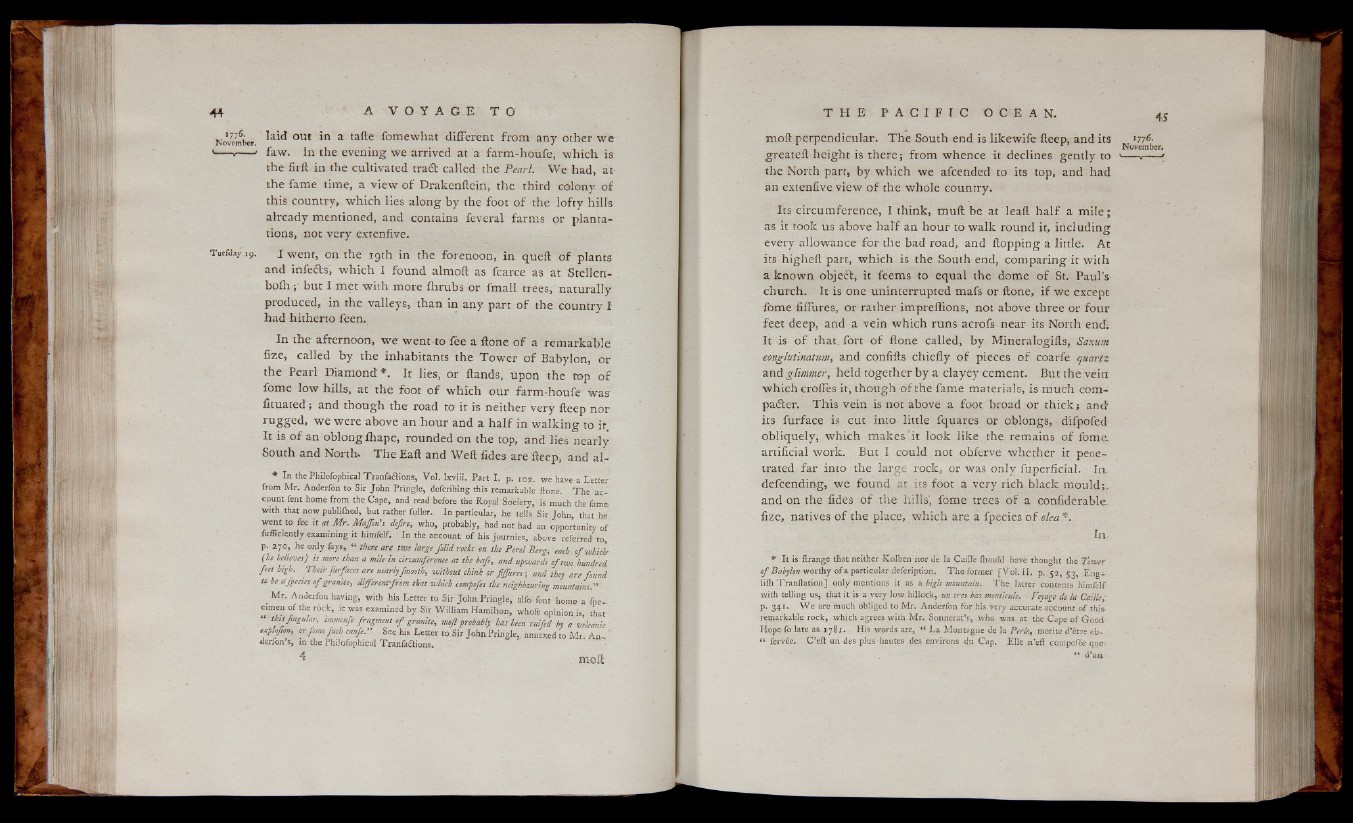
laid out in a tafte fome what different from any other we
faw. In the evening we arrived at a farm-houfe, which is
the firit in the cultivated trait called the Pearl. We had, at
the fame time, a view of Drakenftein, the third colony of
this country, which lies along by the foot of the lofty hills
already mentioned, and contains feveral farms or plantations,
not very extenfive.
Tuefday' i 9. j went, on the 19th in the forenoon, in queft of plants
and infeits, which I found almoft as fcarce as at Stellerr-
boih ;■ but I met with more Ihrubs or fmall trees, naturally
produced, in the valleys, than in any part of the country I
had hitherto feen.
In the afternoon, we went to fee a done o f a remarkable
fize, called by the inhabitants the Tower o f Babylon, or
the Pearl Diamond*. It lies, or ftands, upon the top o f
fome low hills, at the foot of which our farm-houfe' was
iituated ; and though the road to’ it is neither very deep nor
rugged, we were above an hour and a half in walking to it.
It is of an oblongihape, rounded on the top, and lies nearly
South and North, The Ead and Wed fides are deep, and al-
* In the Philofophical Tranfaflions, Vol. Ixviii. Part I. p. 102. we have a Letter'
from Mr. Anderfori to Sir John Pringle, defcribing this remarkable ftone. The ac-
count lent home from the Cape, and read before the Royal Society, is much the fame
with that now publiihed, but rather fuller.. In particular, he tells Sir John, that he.
went to fee it at M r. Maffon's defire, who, probably, had not had an. opportunity of
fufficiently examining it himfelf. In the aecount o f his.Journies, above referred to, I
p. 270, he only fays, “ there are two large folid rocks on the P eril Berg, each o f which
(he believes) is more than a milein circumference at the bafe, and upwards o f two hundred
feet high. Their furfaces are nearly fmooth, without chink or fiffures; and they are fu n d
to be afpedes o f granite, different-from that which compofes the neighbouring mountains.”
Mr. Anderfon having, with his Letter to Sir John.Pringle, alfo fent home a fpe- •
c.men of the rock, it was examined by Sir William Hamilton, whofe opinion.«,-that
“ this fingular, immenfe fragment o f granite', mojl probably has been raifed by a volcanic 1
explofion, or.fome fuch taufc.” See. his Letter to Sir JohniPringle, annexed to Mr. A n , '
derfon’s, in the Philofophical TranfaiHons.
mod perpendicular. The South end is likewife deep, and its >776-
/t i_ • r Novembi greateit height is there; from whence it declines gently to ' «—
the North part, by which we afcended to its top, and had
an extenfive view of the whole country.
Its circumference, I think, mud be at lead half a mile;
as it took us above half an hour to walk round it, including
every allowance for the bad road, and dopping a little. At
its highed part, which is the South end, comparing it with
a known objeft, it feems to equal the dome of St. Paul’s
church. It is one uninterrupted mafs or done, if we except
fome fiffures, or rather impreffions, not above three or four
feet deep, and a vein which runs acrofs near its North ends
It is of that, fort o f done called, by Mineralogids, Saxum
eonglutinatum, and confids chiedy of pieces o f coarfe quartz
and glimmer, held together by a clayey cement. But the vein
which erodes it, though of the fame materials, is much comparer.
This vein is not above a foot broad or thick; and
its furface is cut into little fquares or oblongs, - difpofed
obliquely, which makes’ it look like the remains of fome.
artificial work. But I could not obferve whether it penetrated
far into the large rock, or was only fuperficial. In
defcending, we found at its foot a very rich black mould;,
and on the fides of the hills', fome trees of a confiderable.
fize, natives of the place, which are a fpecies of olea *.
In-
*' It is ftrange that neither Kolben nor de la Caille ihould have thought the Tower
o f Babylon worthy of a particular defcription. Theformer [V o l.I I . P..52 , 53, Eng-
liih Tranllation] only mentions it as a high mountain. The latter contents himfelf
with telling us, that it is a very low hillock, un tres bas monticule. Voyage de la Caille -
p. 341. W e are much obliged to Mr. Anderfon for his very accurate account of this
remarkable rock, which agrees with Mr. Sonnerat’s, who was at the Cape of Good
Hope fo late as, 17S i . His words are, “ La Moptagne de la Perle, merite d’etre ob-
“ fervee. C ’eft un des plus hautes des environs du. Cap. Elle n’eft compofee qye:
, > ‘ d’u n .